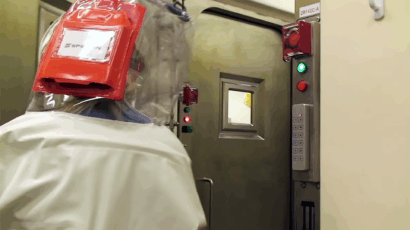Making domestically produced medical isotopes a national priority
By Edwin S. Lyman | December 18, 2008
Despite the clinical importance of medical isotopes, used in an estimated 18 million procedures per year in the United States alone, the world’s supply is increasingly unreliable due to antiquated reactors. At one point in August, all five of the most important medical isotope-producing reactors, all located outside of the United States, were inoperable. The simultaneous shutdowns resulted in supply interruptions, causing a rationing of medical procedures in some areas. Problems are likely to persist for months because one of the largest reactors requires significant repairs.
But the reliance on old reactors causes more than just supply problems; it also poses safety and security dangers. Small-sized medical isotope reactors aren’t required to have the same extensive safety and security features (i.e., robust containments and armed guards against terror attacks) that larger nuclear power plants have, leaving them vulnerable to accidents or sabotage that could endanger nearby communities by releasing significant quantities of radioactive iodine and other hazardous radionuclides into the environment.
Worse yet, the largest medical isotope suppliers continue to employ a production process that irradiates targets made from nuclear weapons-usable highly enriched uranium (HEU), while refusing to consider using more secure low-enriched uranium (LEU). (See “Nuclear Medicine’s Double Hazard.”)
The National Academy of Sciences (NAS) will release a study in January that addresses the feasibility of converting existing HEU-based medical isotope production to LEU. But if the NAS concludes that conversion is feasible, risk-averse suppliers will likely still be reluctant to incur even the modest expense of conversion in the absence of significant pressure and incentives.
Establishing a U.S. production capability
Given the risks associated with the foreign facilities now providing the United States with molybdenum 99, the radioactive isotope that decays into technetium 99m used in medicine, the development of a domestic LEU-based production capability should be a high priority. Yet current efforts to establish domestic production have not received the financial backing and political support they require.
A proposal to use a research reactor at the University of Missouri to produce molybdenum 99 is the domestic option that could be implemented most quickly. Proponents of the $40-million project claim that production could begin as soon as 2012 and could meet one-half of U.S. demand.
While this would be a good interim solution, it would not be appropriate for the longer term. The Missouri reactor is more than 40 years old, and although the isotope production target material would be LEU-based, it currently uses HEU fuel. Conversion of the reactor to LEU fuel is contingent on the successful development of a novel, high-density uranium-molybdenum alloy fuel, which looks promising but is still many years from industrial application. A populous area like Columbia, Missouri, is also not an optimal setting for a commercial-scale target irradiation and processing operation. It would be far more preferable to build a new reactor and processing plant at a remote and heavily secured location such as an Energy Department site, with the reactor and processing facility optimized for use of LEU in both fuel and isotope production targets.
Virginia-based Babcock and Wilcox (B&W) is developing a competing proposal to produce molybdenum 99 in an experimental reactor whose fuel isn’t solid but is a solution consisting of LEU dissolved in water. This concept provides some advantages for radioisotope production, as there’s no need for separate irradiation of targets–the liquid fuel itself is periodically cycled through a processing facility to extract molybdenum 99. The reactor, however, poses some unique safety, off-gas, and waste concerns and would likely be subject to an extensive licensing review by the Nuclear Regulatory Commission (NRC). B&W estimates that building a 200-kilowatt reactor capable of producing 20 percent of U.S. demand would cost less than $100 million and take 5-6 years to complete after full funding is obtained.
But neither proposal has secured the financing necessary to move forward at this time. Although B&W has said that it doesn’t seek government support, the need for a steady supply of medical isotopes is too important to be left to market vagaries, especially at a time when the availability of credit is at a historic low. Government backing would also relieve some of the commercial pressures that might cause new entrants to cut corners on safety and security. Nonetheless, the government has refused to fund such a project, insisting that it be commercially viable on its own.
That hasn’t always been the case. In 1996, Energy recognized that “the medical isotope market is influenced by forces other than traditional market forces” when it issued a record of decision to use taxpayer funds to develop a domestic molybdenum 99 supply, a decision that it never carried out. Energy should return to this position in light of the government’s newfound willingness to provide significant financial support to a range of industries, and the undeniable need for a stable supply of medical isotopes.
Unfortunately, the trade and professional organizations whose U.S. members have the most to gain from a project are doing little to promote it. At an October Reduced Enrichment for Research and Test Reactors (RERTR) meeting, Roy Brown, Senior Director of Federal Affairs at the Council on Radionuclides and Radiopharmaceuticals, said that his organization wasn’t actively pursuing the development of a U.S.-based molybdenum 99 supply because its members don’t operate nuclear reactors. Meanwhile, the Society for Nuclear Medicine has undertaken a modest effort to investigate options, but appears to be doing little to actually promote a solution.
The passivity of these organizations in the face of the ongoing isotope crisis is a marked change from the aggressive lobbying campaigns they waged in 2005 to significantly weaken a 1992 law, known as the Schumer amendment, which tied U.S. exports of HEU for research and isotope production to a commitment on the part of reactor operators to actively pursue conversion of their facilities to LEU. (See “Bomb-Grade Bazaar.”) Even though the weakened law allows foreign companies to receive U.S.-origin HEU for isotope production without engaging in any target conversion activities, these trade groups continue to blame efforts to eliminate the use of HEU in isotope production as contributing to the current supply shortfall. These claims clearly have been proven false, as the reliability of isotope supply has only decreased in the three years since the Schumer amendment was weakened.
Therefore, organizations such as the Council on Radionuclides and Radiopharmaceuticals and the Society for Nuclear Medicine should be leading a vigorous effort to highlight the critical need for a domestic medical isotope supply. Otherwise, it will appear that they’re more interested in defending the commercial interests of existing producers–whose market share and continuing use of HEU would be threatened by the entry of new, large-scale, LEU-based producers–than protecting the health of U.S. patients who need these procedures.
Either way, the United States shouldn’t rely solely on the private sector to develop a domestic LEU-based medical isotope production capacity that will eliminate our dependence on foreign, antiquated reactors and nuclear bomb-grade uranium. It’s an initiative that must become a national priority. Hopefully then, Congress and the incoming Obama administration will take the appropriate steps to facilitate the development of such a supply, consistent with the highest levels of safety and security.
Recommendations
- Energy should prepare a supplemental environmental impact statement to analyze all new options for domestic medical isotope production and reaffirm its 1996 decision, never carried out, to produce molybdenum 99 in the United States. The analysis should consider both interim (5-15 years) and longer-term options. Energy should only evaluate options that utilize LEU for production targets and phase out any use of HEU fuel as soon as practical.
- The government should evaluate a range of incentives to attract bidders for an isotope production contract, such as loan guarantees, tax credits, and guaranteed-price purchase agreements. It should also investigate if these measures could be partially offset by imposing tariffs on the import of isotopes produced with HEU targets.
- Congress should provide sufficient funding to allow Energy to issue a request for proposals and let a contract, while ensuring through statute that any such projects would be conducted under strict financial and management oversight (e.g., by the Government Accountability Office) and be regulated by the NRC.
- The NRC should initiate a rulemaking on the safety and security of isotope production reactors, taking into account potential severe accident and sabotage risks.
- Congress should reinstate the 1992 Schumer amendment to ensure that the United States doesn’t undercut a domestic LEU-based enterprise by supplying foreign competitors with HEU indefinitely, providing them with an unfair advantage.
Together, we make the world safer.
The Bulletin elevates expert voices above the noise. But as an independent nonprofit organization, our operations depend on the support of readers like you. Help us continue to deliver quality journalism that holds leaders accountable. Your support of our work at any level is important. In return, we promise our coverage will be understandable, influential, vigilant, solution-oriented, and fair-minded. Together we can make a difference.
Topics: Nuclear Energy, Opinion















